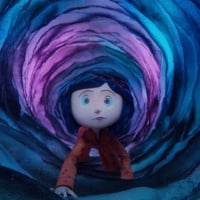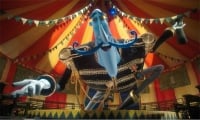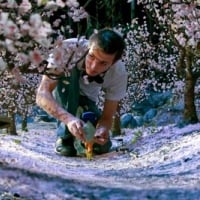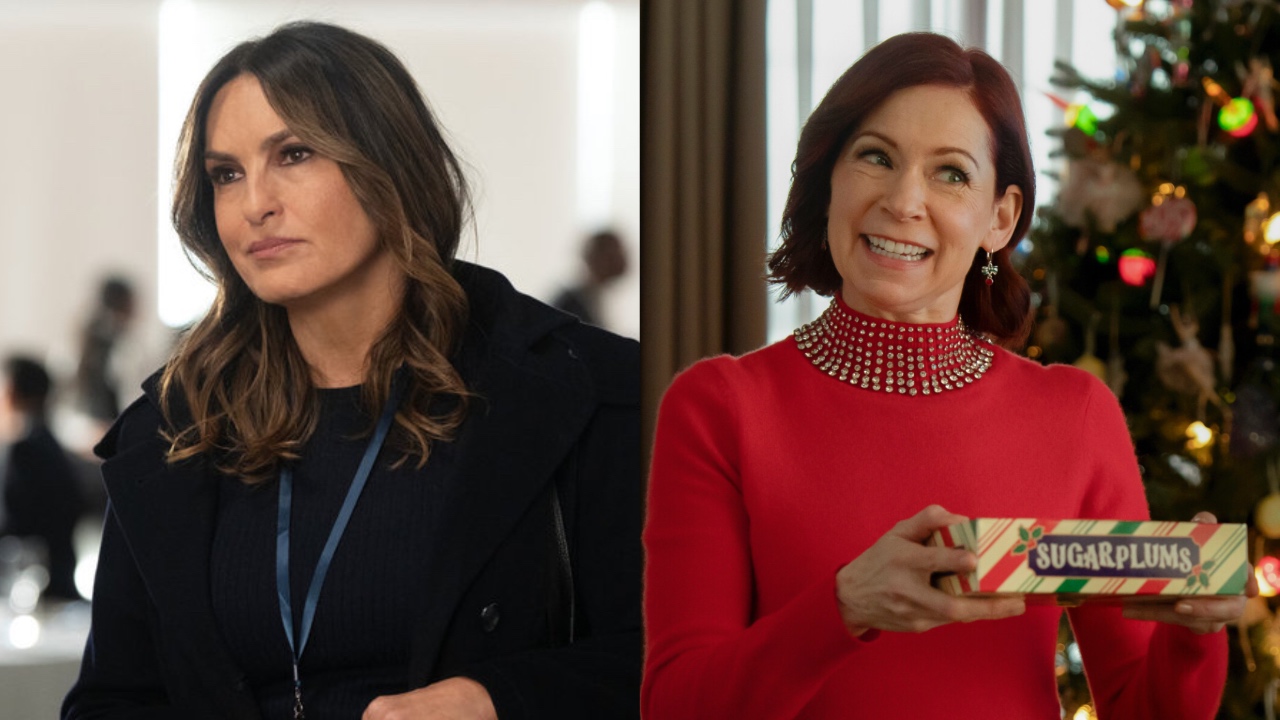Exclusive Interview: Coraline Director Henry Selick

Coraline, the new movie from Nightmare Before Christmas director Henry Selick, is terrifying, exciting, magical, and flat gorgeous. An adaptation of the novel by Neil Gaiman, Coraline isn't afraid to tap into legitimate childhood fears, but it's also captivating in its use of imagination and sense of adventure.
Selick, who also directed James and the Giant Peach, is unapologetic about the movie's scarier elements, and enthusiastic about his movie's ability to entertain and inspire. Shot entirely through stop-motion animation, and featuring some insanely intricate details, Coraline is a world unto itself, and one that Selick clearly enjoyed creating. In our exclusive interview, Selick spoke about the necessary changes made from the book, how the movie scares kids without going too far, and how hard it's become to fight against the growing trend of CG-animted movies. His answers are long, but incredibly thoughtful, and well worth a read. Check out the interview below.
Can you talk about some of the things that you changed between the book and the movie?
It's difficult at times to explain why things changed, how they changed, but my problem with the first draft was it was too faithful, and it did not actually feel like a movie. Nobody liked the first draft, including Neil, even though it was incredibly faithful. [When I decided to add the character of Wybie] I realized that Coraline needed someone in her real world to talk to. Another kid seemed the most simple way to go. I set it in the U.S.. I kept a few characters British. Everyone was British in the novel. I wasn't comfortable rewriting dialogue and trying to hold on to that. And there's other details. The rhythms of a film are always different than a novel. You always have three acts. In the book she goes to this other world, and it's very much a real place. I needed to have her go back and forth several times to build up. It's multiple trips, and I decided to make it seem like a dream. You don't know if it's real until it is. Beyond that, there's lots of tiny adjustments. Even the most different things in the book, most of them come from something, even if it's not used in the same way.
Is the movie funnier than the book? Did you add lightness?
I think you'd be surprised. Several people have done recordings of the book, but Neil's in particular, there's a lot of very dry humor. I think it's lighter in places, but it definitely goes as dark when it needs to. I tried to avoid gags, jokes, and make it more humor derived from the characters.

Was there a challenge in trying to keep some of the darker parts of it?
Your Daily Blend of Entertainment News
Oh yeah. In the United States, animation can only be one thing. It's very hard to push it beyond these boundaries. There's the animation ghetto of feature films in this country. There's this flavor at Dreamworks, and Pixar does their own thing, and generally they're safe. But if you look at Walt Disney's original films, at the time and in the context, they weren't safe. They were really dark and troubling. The evil queen wants Snow White's heart cut out and put into a box. All we're doing is tapping into something that goes back to Grimm's Fairy Tales and ghost stories around a campfire. Kids love to be scared; we all do. But there's a difference between leaving them hanging out there, with their fears, and then bringing them safely home. Kids love it when someone like them stands up against real evil, something really horrendous and frightening, and win. I call the film and the book sort of a combination of Alice in Wonderland and Hansel and Gretel. Two classics, but they last forever. Everyone wants to hear the stories again. The book I think it goes to the dark land sooner and lives there longer. I started in a place where, besides having buttons for eyes, the Other Mother in that world seems very inviting. Then when it goes to the dark place, there's more contrast. On the overall graph of light to dark and sweet to bitter, there's a little more range in the film.
What motivated your decision to film in 3D? Was it inspired by Nightmare Before Christmas being re-released in 3D?
It's a coincidence that Nightmare was treated in post to become 3D. They did a great job. I've been involved in 3D, thinking about it, for more than 20 years. So the 3D was developing in the long gestation period for the movie, and it just worked out that by the time I was ready to shoot it, there were enough screens to convince the producer that this is a good thing to do. Just like those little Viewmaster slides, there's a inherent magic that's captured in 3D that you can't get in drawn animation or in CG. And it was a story point. I was looking for the Wizard of Oz. Coraline goes from this life, this confined, boring life at home, to this wonderful world. So 3D became the thing to open up the film, to help open it up.

There's technology that's arisen since you started in stop motion that makes it easier for you to do what you do, like the electronic storyboards. But is there also more pressure to use technology rather than making your films by hand? How does technology influence you at this point?
Storyboards are where you sketch out the entire movie, because you edit an animated film before you make it. And at the end of the day, it's still an artist's drawing. They're drawing on electronic tablets now instead of pads, but it's still the same direct connection to the artist, sketching things out. There's all this help, but in many cases I've sort of fought off that help. The mouse circus, the performing mice, that was an area, one of the producers said 'Of course that's CG.' But I said, 'If it is, then it's ordinary. Because anybody could do that.' All the Scottie dogs in the downstairs theater-- we made almost 500 Scottie dogs in this beautiful, huge theater. You can get too much help and lose the important thing you're doing, which is what makes this different from other forms of animation is the feel of the artist's hand.
And is it harder to get people to fund this, with the advancements in CG animation?
Yeah, it has been. After Nightmare Before Christmas-- 15 years ago that came out, then I did James and the Giant Peach. It was the same time that Pixar was coming up. They were hugely successful. They were great stories, great designs, but clearly it was like 'CG's the modern way to go.' Stop-motion had a very hard time getting funded for quite a while. But now, after this much time, the CG element is not new any more. People are interested again in stop motion. They're less expensive to make. They don't have to make as much money. Compared to a Pixar or Dreamworks film, or Blue Sky, they're about a third of the cost.
How have your ideas and style of animation changed since you did Nightmare Before Christmas? There are obviously similarities in the style here, but it's also evolved over time.
If there's a similarity to Nightmare, I think it's as much that it's sophisticated stop motion animation. It's ridiculous detail, things very well lit, worked with the same DP. But my own sensibilities, they change. And what I felt was needed for this film was just a little more subtlety. Nightmare is a little more cartoonish. It's its own complete world, with its own distinctive look, which was very much set by Tim Burton's style and his influence. I wanted this to be unique, and it reflects my own aesthetic. Looking for a place between live action and cartoon, not wanting to get too live-actiony or too cartoonish.

Is it easy to find people to help with the specific details on the film, like the puppet wigs and sweaters?
I don't know-- things just come together. You're looking for what you need. And one-third of the people, one-third of my crew, were veterans of Nightmare Before Christmas. We had this core, strong group of people. We all wanted to go beyond what we've done before.
As someone who doesn't have the patience to put together something like this, I have to ask, how do you do this? What inspires people to go into this?
I think a lot of people imagine, how can you stand to work so long on a project, and they think that you're only happy when it's over. Actually we're kind of sad when it's over. It's like going to art school again. All these incredibly talented artists-- people draw and paint and build, work with metal and plastic. We came up with a whole new way to do face animation. There's invention every day. Every day it's like a feast. It's very grueling, it's very demanding [for the the puppeteers]. Puppets seem like vampires sometimes. They live, and you're depleted. It's tough, but I feel incredibly grateful. I get to orchestrate all these amazing talents in a common goal. Anyone who thinks it's crazy, how can you have the patience... if they just came by the sets while we were making the film, they'd understand.
Do you know what you're doing next?
I'm supporting a young director, Chris Butler, for his first film. It's his own original idea, Chris Butler's Paranorman It's kind of a funny zombie tale. I am working on a Philip Pullman, but not the big Golden Compass. Something he did earlier called Count Karlstein.
Staff Writer at CinemaBlend

